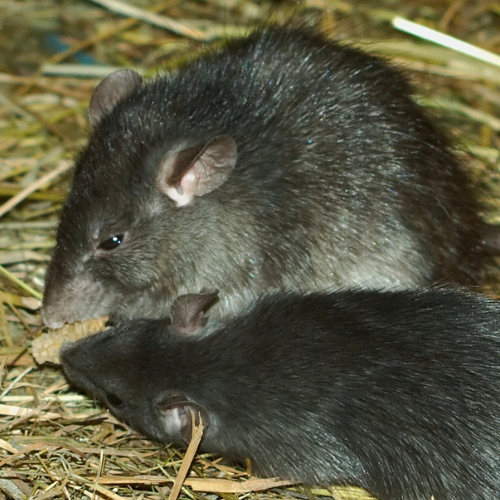Roof Rat

Proud Supporter of Disabled Veterans
No Contracts
Services provided without written contracts.
Introduction to
Roof rats, also known as black rats or ship rats, are common pests in urban and suburban areas. Known for their agility and climbing skills, these rats often inhabit the upper parts of buildings, such as attics and ceilings. They are notorious for causing significant damage to structures, contaminating food sources, and spreading diseases. This article will explore the recognition, biology, habits, prevention, and professional handling of roof rats to help you effectively manage and prevent infestations.
Recognition
Roof rats are typically slender, with a body length of 6 to 8 inches and a tail that is longer than their body. They have smooth, glossy fur that is usually black or dark brown, and their underbellies are lighter in color. Their ears are large and ears are large and ears are large and hairless, and their eyes are prominent. Roof rats are excellent climbers, often found in high places like trees, attics, and rafters. Their droppings are spindle-shaped and about half an inch long. Signs of an infestation include gnaw marks, greasy rub marks along walls and rafters, and the presence of nests made from shredded materials.
Biology
Roof rats are highly adaptable and thrive in a variety of environments, though they prefer warm climates. They are prolific breeders, with females capable of producing several litters per year, each consisting of 5 to 8 young. The gestation period is about 21 to 23 days, and young rats reach sexual maturity at around 3 to 4 months old. Roof rats are omnivores, with a diet that includes fruits, nuts, grains, and even small animals. They have keen senses of hearing, smell, and taste, which help them locate food and detect danger.
Habits
Roof rats are primarily nocturnal, meaning they are most active during the night. They are highly agile and can climb trees, vines, and wires to access buildings. Once inside, they prefer to nest in the upper parts of structures, such as attics, ceilings, and walls. Roof rats are social animals, often living in colonies. They are cautious and tend to avoid new objects in their environment, making them difficult to trap. These rats are known for their destructive behavior, gnawing on electrical wires, insulation, and wood, which can lead to fire hazards and structural damage.
Prevention
Preventing a roof rat infestation involves a combination of sanitation, exclusion, and monitoring. Start by eliminating potential food sources by securing garbage bins, cleaning up fallen fruits, and storing food in sealed containers. Trim tree branches and vegetation away from your home to prevent rats from gaining access. Seal any gaps or openings in your roof, walls, and foundation with materials like steel wool or caulk. Regularly inspect your property for signs of rat activity and set up traps or bait stations as a proactive measure. Maintaining a clean and clutter-free environment can also deter roof rats from nesting in your home.
Professional
If a roof rat infestation is beyond your control, seeking professional help is essential. STL Pest Control offers comprehensive services to manage and eliminate roof rat problems. Their trained technicians will conduct a thorough inspection to identify entry points and nesting sites. Using a combination of traps, baits, and exclusion techniques, they will effectively remove the rats from your property. Additionally, STL Pest Control provides ongoing monitoring and maintenance to ensure that the infestation does not recur. Professional pest control services are crucial for addressing severe infestations and preventing potential health risks associated with roof rats.



Our Office







